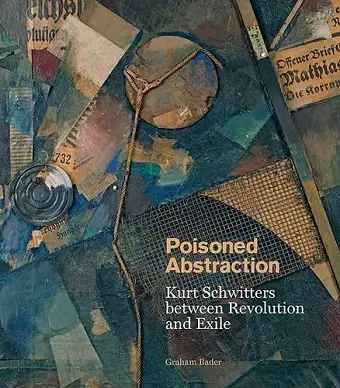Poisoned Abstraction
Kurt Schwitters between Revolution and Exile
Format:Hardback
Publisher:Yale University Press
Published:23rd Nov '21
Should be back in stock very soon

A definitive resource, full of fresh insights and new revelations, on one of the most influential interwar artists
This richly illustrated book offers a definitive new assessment of the oeuvre of Kurt Schwitters (1887–1948), a central figure of the interwar European avant-garde. Active as an artist, designer, publisher, performer, critic, poet, and playwright, Schwitters is best known for intimately scaled, materially rich collages and assemblages made from found objects—often refuse—that the artist described as having lost all contact with their role and history in the world at large. But as Graham Bader explores, such simple separation of art from life is precisely what Schwitters’s “poisoned abstraction” calls into question.
Considering works reaching from Schwitters’s earliest collage-based pieces of 1918–19, through his 1920s advertising designs, to his seminal environmental installation the Merzbau, Bader carefully unpacks the meaning behind such projects and sheds new light on the tumultuous historical conditions in which they were made. In the process, he reveals a new Schwitters—aesthetically committed and politically astute—for our time. This authoritative account reframes our understanding of Schwitters’s multifaceted artistic practice and explores the complex entwinement of art, politics, and history in the modern period.
“An exceptional example of complex academic research, which has has been elegantly articulated in a well-balanced and beautifully produced volume.”—Beth Williamson, Burlington Magazine
“In Poisoned Abstraction, Graham Bader presents the conflict between actual refuse and abstract composition not as an obstacle to [Schwitters’s] work but as our way into it. . . . On the one hand, the rubbish deployed by Schwitters affronted traditional ideas of artmaking; on the other, its use pointed to a new aesthetic responsive to the ruinous aftermath of the war. To lose this tension—to reject the work as mere trash, as the reactionaries did, or as autonomous art, as the radicals did—is to miss the dialectical force that drives it.”—Hal Foster, London Review of Books
“In this beautiful, lavishly illustrated book, Bader provides an excellent analysis of Schwitters (1887–1948), one of modern art’s most original and versatile figures. Bader sets Schwitters’s creations in the landscape of his times, from his early Merz collages dating around 1919 to his mature production in the 1940s . . . [and] provides a coherent, well-argued analysis of the theoretical forces that actuated the artist’s work, enabling him to cope with exile and radical change. Summing up: Recommended.”—E. G. Wickersham, Choice
“Poisoned Abstraction is the account of Schwitters for our moment. Its comprehensiveness does justice to the complexity of his art and critically expands our understanding of Schwitters himself.”—Bibiana Obler, George Washington University
“A fascinating analysis of Kurt Schwitters’s body of work. Graham Bader successfully makes sense of Schwitters’s often puzzling art, its evolution, and its meaning in a context that shifted dramatically between the two world wars.”—Andrés Mario Zervigón, author of John Heartfield and the Agitated Image: Photography, Persuasion, and the Rise of Avant-Garde Photomontage
“Graham Bader’s elegant study explores key aspects of Kurt Schwitters’s practice, testing the artist’s relay between art and life. In exploring how Schwitters’s works, made from the shards of a devastated modern landscape, create meaning and value, Bader is a thoughtful and probing guide.”—Leah Dickerman, Museum of Modern Art
ISBN: 9780300257083
Dimensions: unknown
Weight: unknown
240 pages